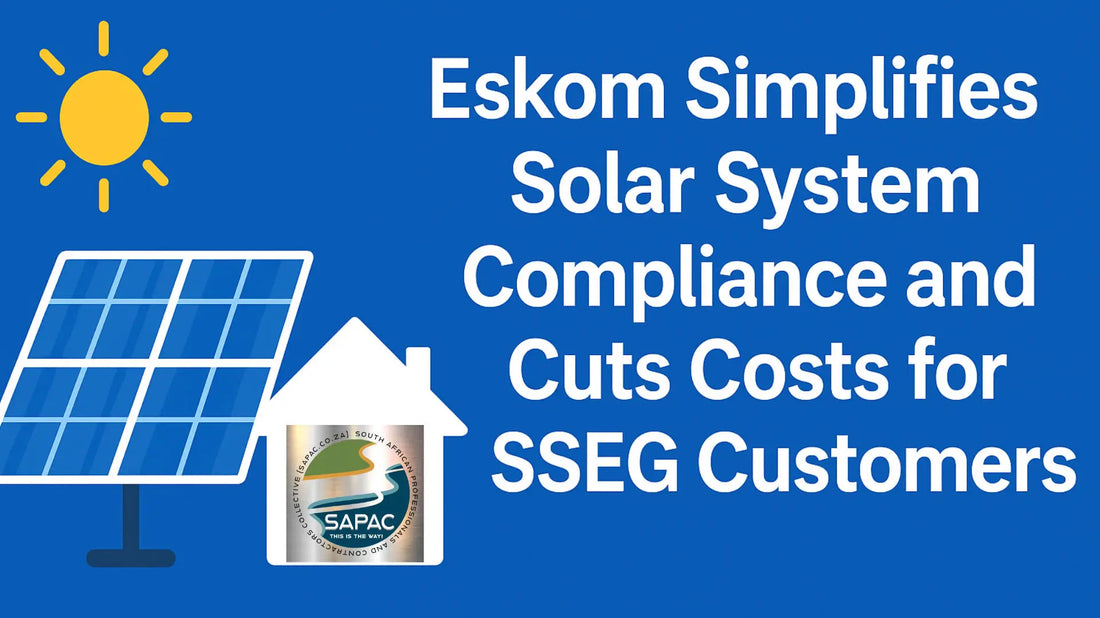
Breaking News Eskom Simplifies Solar System Compliances and Cuts Costs
SAPAC ReporterShare
Eskom Simplifies Solar System Compliances and Cuts Costs for Small-Scale Embedded Generation Customer
Eskom Simplifies Solar Compliance and Extends Cost Relief for Solar Users
21 October 2025 — South Africa
Eskom has announced major improvements to its solar system compliance and registration process, making it simpler, safer, and more affordable for households and small businesses to connect their Small-Scale Embedded Generation (SSEG) systems, such as rooftop solar panels, to the national grid.
The updated framework is designed to help South Africans take part in the clean energy transition, while ensuring all installations remain safe, compliant, and aligned with NERSA (National Energy Regulator of South Africa) regulations.
Easier, Faster Solar System Registration
After extensive collaboration with industry stakeholders — including the South African Bureau of Standards (SABS), SAPVIA, AMEU, and NRS committees — Eskom has streamlined the SSEG registration process that has been in development since 2015.
The key change, effective 1 October 2025, allows residential customers to have their solar systems signed off by a Department of Labour (DoL)-registered electrician (Installation or Master Installation Electrician), without needing a professional registered with the Engineering Council of South Africa (ECSA).
This adjustment follows a comprehensive safety review and aligns with expected updates from the SABS to make compliance more practical and affordable.
“Our goal is to make it as simple, safe, and cost-effective as possible for customers to connect legally,” said Agnes Mlambo, Eskom’s Acting Group Executive for Distribution.
“We encourage customers to register their systems to stay compliant and benefit from future clean energy incentives.”
Why Solar Registration Matters
According to NERSA’s regulations, all SSEG systems below 100kVA — including solar PV systems — must be registered with Eskom or the respective municipal electricity provider, even if the system does not export energy to the grid.
Customers who are fully off-grid (not connected to Eskom’s supply) do not need to register, as long as they can prove complete independence from the national network.
Registering ensures that systems meet technical, safety, and operational standards, protecting both customers and the broader electricity network.
Cost Relief for Households with Rooftop Solar
Eskom has introduced financial relief measures to make legal solar installation more accessible:
No registration or connection fees for systems up to 50kVA until March 2026
Simplified certification process — now handled by qualified DoL-registered electricians
Faster processing times and clear documentation requirements, including a valid Certificate of Compliance (CoC) and basic EGI test report
These updates can save households over R9,000 on average when connecting a typical 16kVA solar PV system. Businesses will also continue to enjoy reduced connection fees introduced in previous years.
Future Benefits for Registered Solar Users
Customers who legally register their systems will gain access to future tariff benefits and energy credit programmes.
For instance, Eskom’s Homeflex tariff rewards solar users who export surplus power back to the grid, offering energy credits that improve their return on investment.
Additionally, upcoming demand response products will allow registered users to save more by shifting energy use to lower-cost periods.
Encouraging Safe, Legal Solar Integration
Eskom continues to emphasize that all SSEG customers must register their solar systems to maintain safety and compliance. The utility remains committed to supporting South Africa’s renewable energy goals through policies that balance accessibility, affordability, and national grid stability.
Work is ongoing to introduce solutions for prepaid customers, ensuring everyone can safely and legally participate in South Africa’s solar energy revolution.
About Eskom’s SSEG Initiative
Since 2015, Eskom has collaborated with leading industry bodies to shape the national approach to embedded generation. The framework is built on NRS097 standards, ensuring every connected system meets the highest technical and safety requirements.
Eskom’s simplified registration model empowers more South Africans to become energy independent, while strengthening the integrity and resilience of the national power grid.
Crucial requirements to note
Crucial requirements to note in order for the system to be complaint are that consumers must note that their systems are signed off by a Department of Labour (DoL)–registered person (excluding single-phase testers), this means that the electrician must be a registered Master Installation Electrician or either an Installation Electrician. The electrician must also be on site throughout the installation process.
